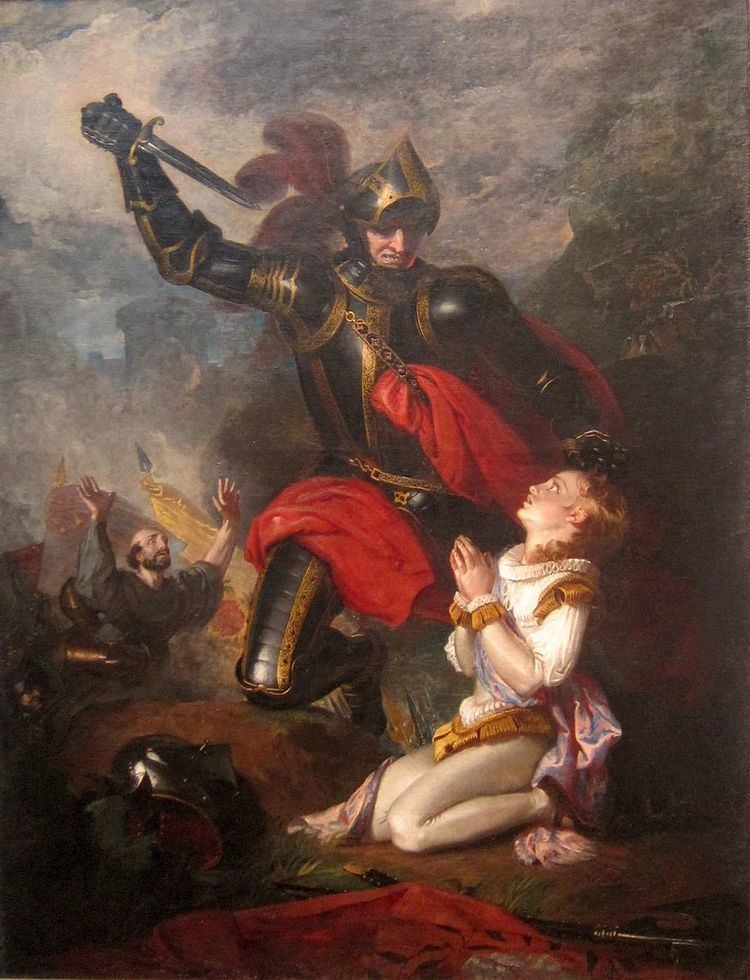Name Edmund, of Siblings Richard III of England | ||
 | ||
Born 17 May 1443Rouen, Normandy ( 1443-05-17 ) Died December 30, 1460, Wakefield, United Kingdom Parents Cecily Neville, Duchess of York, Richard of York, 3rd Duke of York Cousins Richard Neville, 16th Earl of Warwick Grandparents Joan Beaufort, Countess of Westmorland Similar People Richard of York - 3rd Duke of Y, Richard III of England, Cecily Neville - Duchess, George Plantagenet - 1st Duke, Edmund of Langley - 1st Duke | ||
Edmund, Earl of Rutland (17 May 1443 – 30 December 1460) was the fifth child and second surviving son of Richard Plantagenet, 3rd Duke of York, and Cecily Neville. He was born in Rouen. At the time Rouen was the capital of English occupied France and his father held the office of Lieutenant of France. He was killed at the age of 17 either during or shortly after the Battle of Wakefield, during the Wars of the Roses.
Contents
He was created Earl of Rutland by Henry VI probably some time before 1454. No record of the creation has been preserved; Edmund and his older brother Edward, then the Earl of March, signed a letter to their father on 14 June 1454 as "E. Rutland" and "E. Marche".
Lord Chancellor of Ireland
In 1451, Edmund's father, who held the title of Lord Lieutenant of Ireland, appointed Edmund as Lord Chancellor of Ireland. As Edmund was underage, the duties of the position were held by Deputy Chancellors. His first Deputy Chancellor was Edmund Oldhall, Bishop of Meath. His brother Sir William Oldhall was Chamberlain to the Duke of York and was likely behind that appointment. He acted as de facto Chancellor until 1454.
Olldhall was replaced by John Talbot, 2nd Earl of Shrewsbury, who also held the office of Lord High Steward of Ireland. He would continue serving as the de facto Chancellor until his death at the Battle of Northampton (10 July 1460).
His appointment and those of his Deputies were acknowledged by the Parliament of Ireland which at this time first asserted its independence. The Parliament declared that Ireland held separate legislature from the Kingdom of England and its subjects were only subject to the laws and statutes of "the Lords Spiritual and Temporal and Commons of Ireland, freely admitted and accepted in their Parliaments and Great Councils".
According to Parliamentary decisions during his term, the Irish subjects were only bound to answer writs by the Great Seal of Ireland, held by the Lord Chancellors. Any officer attempting to enforce the rule of decrees from England would lose all of his property in Ireland and be subject to a fine.
The House of York in Ireland had won the support of Thomas FitzGerald, 7th Earl of Kildare, and James FitzGerald, 6th Earl of Desmond. Several allies of the FitzGeralds followed them in their loyalties. On the other hand, the House of Lancaster found its main Irish supporter in the person of James Butler, 5th Earl of Ormonde.
Death
Edmund died at the age of seventeen either during or shortly after the Battle of Wakefield (30 December 1460) during the Wars of the Roses. He had fought in the battle at the side of his father. After the tide of battle turned against his father he attempted to escape over Wakefield Bridge, but was overtaken and killed, possibly by the Lancastrian Lord Clifford, in revenge for his father's death at St Albans.
By the account given by Roderick O'Flanagan in his 1870 biography of Edmund:
Urged by his tutor, a priest named Robert Aspell, he was no sooner aware that the field was lost than he sought safety by flight. Their movements were intercepted by the Lancastrians, and Lord Clifford made him prisoner, but did not then know his rank. Struck with the richness of his armour and equipment, Lord Clifford demanded his name. "Save him", implored the Chaplain; "for he is the Prince's son, and peradventure may do you good hereafter."
However this story does not appear in any of the accounts of the battle written by the chroniclers of the time.
Edmund was possibly executed on the orders of the Lancastrian Lord Clifford, or by some accounts, by Lord Clifford himself. His head was displayed on the gates of York, England, along with those of his father and of his uncle, Richard Neville, 5th Earl of Salisbury.
In Shakespeare's play, Henry VI, Part 3, Rutland is portrayed as a young boy who is brutally murdered by Clifford after pleading for his life; the source appears to be Hall's 1548 history, which says, incorrectly, that Rutland is "scarce of the age of twelve years" at his death.
Edmund and his father were buried at Pontefract Priory. The bodies were reburied, with great pomp, in the family vault at Fotheringhay Castle on 29–30 July 1476.
Lord Clifford would himself be slain in March 1461 at the Battle of Ferrybridge.
